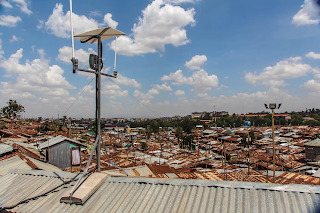 |
| Pia! runs fiber to an area and the "last mile" is wireless. |
A low-cost Windows PC and a 4 Mb/s connection would allow all that I did at that time and so much more today -- download software, articles, books, movies, etc., stream HD 720p video, make voice-over-IP calls, listen to podcasts, read newspapers, etc. and, importantly, create content and invent applications and services that are relevant to Africa. It would be fascinating to conduct a study of Poa! users to see what they are using the Internet for and how it is impacting their lives.
One thing we know for certain is that people do different things with a computer at home than with a phone on a mobile network or at a Wi-Fi hotspot. For example, I could not write this post on my Android phone.
This point is underscored by the experience of Poa!. Poa! CTO Mike Puchol said that when they deployed about 160 outdoor Wi-Fi hotspots in Kibera, a district of Nairobi, users consumed "very little" data despite the price being 10% of the mobile network operator’s rate. When Poa! deployed residential broadband in Kibera, average consumption hit ~140 GB/month right away and is now over 200 GB/month. (In 2021, average mobile data consumption in sub-Saharan Africa was 2.9 GB per month).
Puchol provisions 1.5 Mb/s per 4 Mb/s account and he says there is "very little" contention. No doubt that contention grows during busy hours and days, but if they can add capacity as quickly as they add customers, they would be able to maintain that contention ratio without alienating too many customers.
They have fiber loops between their data center and points of presence in each network area they serve and use wireless links to reach individual houses. The service seems to be financially viable in urban areas like Kibera. Puchol reports that they currently have 20,000 home users and last December 27,000 people used the public street service. Poa! has received over $42 million in funding
Starlink
SpaceX recently began offering Starlink Internet service in Nigeria and Rwanda and several South American nations and will begin service in Kenya next quarter. Could they substitute Starlink connectivity for fiber and offer their service in rural Kenya?
Today, they could not. Today, there is only one Starlink ground station in Africa and it is in Nigeria. The only way a Starlink user in Kenya can reach the Internet is via inter-satellite links from a visible satellite to a remote ground station. I just ran Mike Puchol's Starlink simulation for one hour at a random location in central Kenya and there was no available coverage six percent of the time.
Since SpaceX has committed to offering connectivity in Kenya during the second quarter of this year, I assume they will have reachable ground stations by then. The same goes for Angola, Eswatini, Mozambique, and Zambia, which will have connectivity during the second quarter, and many other African nations that are slated to connect later in 2003 and in 2004. A rural village with access to a ground station could be used for Starlink backhaul.
If there is excess constellation capacity over a village location, the marginal cost of serving a new terminal will be near zero and an ISP can count on adding users at a predictable cost. I've seen a Nigerian Speedtest result showing a download rate of 238 Mb/s, an upload rate of 45 Mb/s, and a latency of 42 ms. At those speeds, a terminal could theoretically support 188 4 Mb/s customers, but that test was run on an unloaded terminal at a particular time of day.
During a day, the available capacity at a given location varies as the satellites move and the number of users online varies. (Large files should be transferred late at night).
In the long run, capacity increases as more satellites are launched and technology improves. SpaceX just began launching second-generation Starlink satellites which provide four times the capacity of the first generation and the next generation is expected to more than double that. The number and capacity of ground stations will also continue to increase, and more satellites with inter-satellite laser links will make it possible to reach them from remote sites. We will also see optical links to some ground stations and terminal cost and performance are also improving.
SpaceX is the only company offering low-Earth orbit broadband connectivity today, but they will have low and medium Earth orbit competitors and several of those future competitors are designing their constellations for organizations and enterprises which may make them better suited than SpaceX for backhaul from a village. For example, OneWeb will offer service-level agreements, which will take some of the uncertainty out of pricing decisions and SES will offer software-defined beam capacities and shapes.
The one prediction I can make given all this variability is that the prices SpaceX is charging in Rwanda and Nigeria today will change over time as they have in the US and other nations.
 |
| Poa! staff |









